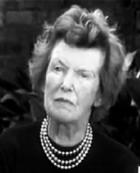
Joan Lindsay (née Weigall) was born in 1896 in St. Kilda East, Victoria, Australia. He was a descendant of the Boyd family, perhaps the most famous and prolific artistic dynasty of Australia. From 1916 to 1919 he studied painting at the National Gallery School in Melbourne, and even went on to exhibit as a painter. He married Daryl Lindsay, scion of an important family of English artists and writers, on Valentine's Day 1922, in London. Day that, precisely, would be chosen by Joan Lindsay to situate the facts of his most famous novel, Picnic in Hanging Rock. The marriage settled in Australia, where Joan Lindsay would dedicate himself to painting, until, after the Great Depression, Daryl was hired as director of the National Gallery of Victoria. In 1956, he was knighted by the British Empire. Although Joan's first novel, Through Darkest Pondelayo, a satire on English tourists, was published in 1936, it was not until 1962 when his first notable work, Time Without Clocks, was published, a text with strong autobiographical content in the who portrayed the first years of her married life. The real success would come, however, with Picnic in Hanging Rock (1967), which automatically brought him world fame, and which would become in its own right one of the most remarkable cult novels in Australian literature. Set in 1900, it tells the story of the disappearance of some girls and their governess during a trip made on Valentine's Day. Part of the success of the novel was based on the fact that the author never revealed if the narrated was a real event or not. The extraordinary impact of the work persecuted Lindsay until the day of his death, and constituted a before and after in the history of Australian literature of the twentieth century. It was adapted to the cinema in 1975 by a young Peter Weir, and translated into several languages. Joan Lindsay died of natural causes in Melbourne, in 1984.




